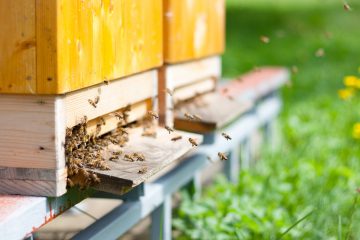Last Updated: 27 November 2025
Are you interested in picking up beekeeping? Or are you looking to optimize your approach? There are a few types of beehives to choose from.
Do you want as many bees and as much honey as possible? Would you rather have something smaller and easier to manage? Do you prefer the most natural environment for the bees? Or the most convenience?
There’s no universal best option, bees are adaptable creatures. You have a few choices to make to make for yourself and your bees.
This easy guide will help you understand the types of beehives and pick out the best one for your needs.
Table of Contents
What’s a Bee Looking For in a Home
You shouldn’t begin trying to decide which box is the best or “most natural” for keeping bees. Instead, focus on learning more about the bees and what they want and need.
Knowing bee behaviour and what goes on inside the hive is more important than the wooden box where they live.
Studies have revealed that most wild colonies nest in trees. They prefer small holes (no bigger than five square inches) facing south. Ideally close to the ground. The average volume of the nest cavity is roughly 41 quarts.
Honeybees are adaptable. You may find various natural types of beehives in places such as birdhouses, rock crevices, buildings, and empty boxes.
The size and location of the opening are what matter most. Bees like small holes that face south or east.
Most modern types of beehives replicate the characteristics of wild honeybee colonies. A dark, protected enclosure with a small, defensible entrance. And, of course, plenty of room for parallel comb construction.
Bees aren’t very picky, and you can build your own perfect hive. It’s also important that you consider your own safety before handling bees, take a read of our guide on the Best Beekeeping Suits for more information on the most appropriate suit for your requirements!
Types of Beehives
There are three types of beehives to choose from. Langstroth hives, Warre hives, and Top bar hives.
Let’s look at each one.
The Langstroth Hive
The most recognizable hive. It was invented by Rev. Langstroth, known as the father of modern beekeeping, in 1851.
The purpose was to be able to move frames without harming bees and comb. This lets you inspect with ease because you can move the comb. The invention revolutionized the world of beekeeping.
The hive consists of a super (wooden box) with 8-10 vertical hanging frames inside. There’s an entrance at the bottom and a removable top with two covers. When the colony grows, you replace the top with a new super.
Most frames have a thin foundation with a hexagonal pattern that shows the bees how to draw out the comb. More beekeepers are starting to avoid foundation. The idea is that it limits the cell size.
This is a very common hive and it’s easy to find resources and mentors. Another advantage is you won’t have cross comb issues.
The Warre Hive
This hive, invented by Emile Warr, is also known as “the people’s hive.”
It’s a supered hive where the bees draw out their comb without frames and foundation. Each super has eight top bars instead. The supers are smaller than on the Langstroth to mimic the natural average.
The top quilt box and gabled roof provide insulation and moisture regulation. New supers are added from below, bees tend to expand downward in nature. Adding new supers can get quite heavy. And there’s no easy way to add a feeder.
Colonies in Warre hives tend to produce less honey. If maximizing honey is your main goal, the Langstroth is a better choice. There’s also an increased risk of cross comb and mite infestations.
However, if you’re looking for a simple, natural hive with a more manageable supersize, the Warre hive is a great choice.
If you’re looking for a Warre Hive, we recommend the Beeologique 3-Box Hive.
The Top Bar Hive
This type, also known as the Kenyan top bar hive, has become popular with the trend of “going natural.”
There’s a large, horizontal hive body where the sides are sloped. There are many wide top bars, placed close together. Most keepers add a top lid to protect against the weather. In the winter, the norm is to place blankets on top for insulation.
This design has no foundations, frames or supers. It’s all one, horizontal unit. It’s heavy, so once it’s working you’ll need help relocating it. Choose your spot carefully.
Inspections are easy, you just lift one bar. Since the hive stays more or less closed up, the bees tend to stay calm. Make sure to keep the comb vertical, otherwise, it can break off the top bar.
There’s often a window on one side so you can look into the hive. There’s a shutter to keep the hive dark. Looking in doesn’t equal an inspection. You need to inspect often to prevent developing cross comb.
The hive features a screened bottom and a slide-out board, so you can increase ventilation and collect mite fall. Placing a sticky board under the screen helps with counting mites.
These types of beehives are gaining popularity because of the simple design. It lets bees draw their own comb, yet remains easy to inspect.
Foundation or No Foundation?
Let’s look at the pros and cons of a foundation.
Frames with foundation help prevent cross comb. They also take care of mite problems. The foundation coating contains a small amount of acaricides that kill the mites.
You may not like the idea of pesticides and other contaminants in your colony’s wax though.
The predetermined pattern of foundation changes how your bees draw their comb. Without foundation, they’ll build combs of different sizes to store honey and raise new bees. This is beneficial to the bees.
Hives without frames and foundations do require a lot of inspection when the colony is getting established. Otherwise, you risk a lot of cross comb problems.
Summary of Types of Beehives
Your understanding of bees should be the main deciding factor. Beehive type is mostly about your preference, wild bees live in all sorts of spaces.
The Langstroth hive is big, popular, and tends to yield more honey. The Warre hive is a smaller, simpler variation. The Top bar hive is big and simpler than the Langstroth.
Foundationless options are more beneficial to the bees. But they need many inspections to prevent cross comb. And there’s no inherent protection against mites.
If you’re interested in looking at the beehives that we recommend here at EbeeHQ, take a look here at the list of recommended Bee hives for sale. Additionally, if you’re looking for a solution which contains a beehive and all of your additional beekeeping tools, take a look at our recommended list of bee starter kits.

